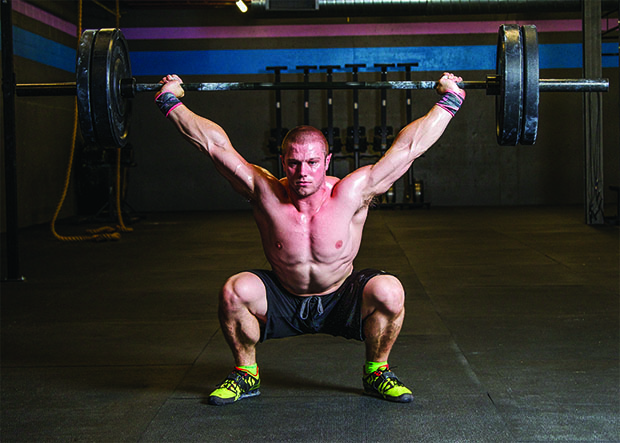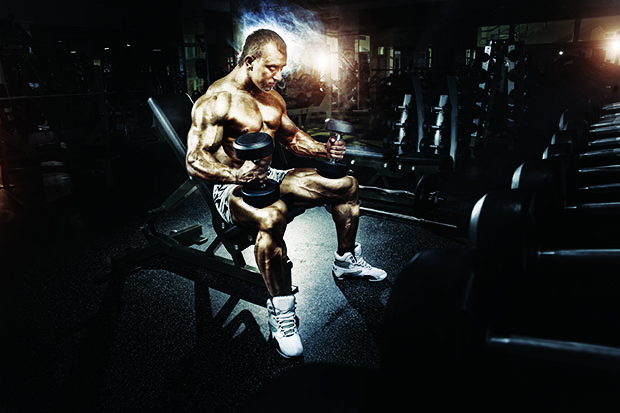


The ability to press, stabilize, and move with weight over your head is an integral part of optimizing your training. Strength and conditioning coaches place an emphasis on proper technique, sometimes prioritizing movement patterns over specific muscles trained. For upper body, the ability to horizontally push (bench press), horizontally pull (row), vertically push (overhead press), and vertically pull (pull-up) are all important movement patterns that need to be mastered to ensure lifters possess a balanced body in both strength and aesthetics.
Overhead pressing is an often underutilized exercise. The shoulder is a very delicate joint, and extreme care must be shown when developing it. Having the strength to perform overhead pressing, as well as having the proper flexibility in key joints, will greatly minimize your risk of injury.
When most people think about training their upper body, they automatically think bench press. Now this article is by no means a ploy to take you away from benching, but when you’re pinned down on a bench, your shoulder blades remain squeezed together. Over time, you shoulder blades lose their ability to move freely. (These “floating” bones are very mobile, having the ability to rotate outward, squeeze together, lift upward, and depress downward.) This is one important reason why everyone should perform vertical-pressing movements. Pressing over your head allows your shoulder blades to move in their natural rhythm, which helps to prevent injuries.
Freedom Of The Press
When overhead pressing, take into consideration your daily living conditions and how they may affect your training. Since the majority of Americans have jobs sitting down, over time their shoulders become rounded, resulting in their pectoral muscles becoming shortened and their spine being forced into constant kyphosis. Also keep in mind that every lifter loves to bench press, which shortens the chest muscles even more. Most people don’t train their back or rear deltoids as much as they should, so over time this causes problems. When you develop these issues, pressing a barbell overhead can become a glitchy painful nightmare. In order for you to push that weight skyward, you must do some funky things with your lower back to compensate for your compromised mobility. Many people need to drastically hyperextend the lumbar spine. If you attempt to keep your back flat and straight, you’ll quickly realize that your flexibility issues won’t allow that barbell to be pressed over-head in a correct path.
A great assessment tool for realizing imbalances is the back-to-wall shoulder flexion. This exercise will help you identify what kind of preparation you may need to do prior to lifting a weight overhead. Place your feet about six inches away from a wall and put your butt, back, and head against the wall. Leading with your thumbs, bring your arms straight out in front of your body and then over your head, touching your thumbs to the wall over your head. If your back, butt, or head lose contact with the wall or you must do anything compensatory to allow this movement to happen, you will need to spend some time doing prep work before continuing to put weight over your head.

Strict overhead pressing is not only an effective strength-building exercise, it is the foundation for more advanced moves such as the push-press and overhead squat. When you begin pressing, keep these cues in mind:
• Set the squat rack up so an Olympic bar is loaded onto J-hooks that are even with your armpits.
• When you address the weight, grab the bar just outside your shoulders.
• Make sure your elbows are directly located under your wrists. This will allow you the most power to press the bar overhead.
• Your feet should be between hip- and shoulder-width apart, but this is a personal preference.
• Try to keep your wrists as straight as possible. One thing I always cue people on is to “punch the sky.” Make sure your wrists are straight and keep your knuckles pointed to the ceiling.
• When you are about to press, squeeze your glutes. This helps tremendously since it takes a ton of pressure off your lower back.
• Tuck your chin in and press the bar in one smooth motion over your head. When you do this, it allows the bar to be pressed directly overhead up without moving off a straight bar path. If you don’t tuck your chin, you might jam the bar into your chin or you’ll need to press the bar forward to go around your head.
• Do not make the mistake of leaning back to press it, as this will put you at risk of blowing a disc in your back.
The amount of sets and reps you perform are based off your goals and training experience. If you’re just beginning, aim for four sets of six to 10 reps. If strength is your goal, then stay under five reps. If you’re looking to build muscle mass, operate between six and 12 reps. And if you’re doing this for fat loss, such as in a metabolic circuit, then bump it up to between 12 to 20 reps.
There are a few accessory exercises that can help to build the strength and stability needed to press overhead efficiently. I’m a fan of single-arm overhead walks, also known as waiter carries. Grab a kettlebell or dumbbell and press it overhead. Walk a certain distance (I recommend 20 yards) with the dumbbell overhead and your arms and shoulders locked into a stable position. You should be standing up-right with a stiff and stable torso. This is a great way to build dynamic stability in your shoulders.
Another exercise I advocate is the basic dumbbell Arnold press. This is a bodybuilding favorite and rightfully so. The shoulder is a ball-and-socket joint, and this exercise helps to keep that shoulder moving in its natural rotational motion, as opposed to a fixed up-and-down movement.
Overhead pressing is an exercise that often gets thrown into the mix with “The Big Three” (squat, bench, deadlift). It’s a great way to build strength in your shoulders, as well as determine if you have any mobility issues. Big benchers know the importance of having strong shoulders, so adding overhead presses into their routine will help your bench-press numbers grow. The addition of overhead presses into your weekly training—and then using that strength to add new exercises such as push-presses and overhead squats—will allow you to experience gains in your performance that you didn’t know were possible.
Cornell Hunt is a Certified Strength and Conditioning Specialist in New Jersey who works with pro and amateur athletes. He is the MHP Xtreme training coach. For more information, log on to MHPStrong.com.






















You must be logged in to post a comment Login